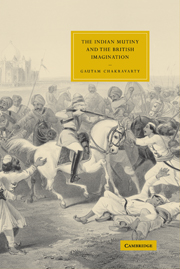Book contents
- Frontmatter
- Contents
- Acknowledgements
- Glossary
- Introduction
- 1 From chronicle to history
- 2 Reform and revision
- 3 Romances of empire, Romantic orientalism and Anglo-India: contexts, historical and literary
- 4 The ‘Mutiny’ novel and the historical archive
- 5 Counter-insurgency and heroism
- 6 Imagining resistance
- Epilogue
- Notes
- Bibliography
- Index list
- CAMBRIDGE STUDIES IN NINETEENTH-CENTURY LITERATURE AND CULTURE
4 - The ‘Mutiny’ novel and the historical archive
Published online by Cambridge University Press: 22 September 2009
- Frontmatter
- Contents
- Acknowledgements
- Glossary
- Introduction
- 1 From chronicle to history
- 2 Reform and revision
- 3 Romances of empire, Romantic orientalism and Anglo-India: contexts, historical and literary
- 4 The ‘Mutiny’ novel and the historical archive
- 5 Counter-insurgency and heroism
- 6 Imagining resistance
- Epilogue
- Notes
- Bibliography
- Index list
- CAMBRIDGE STUDIES IN NINETEENTH-CENTURY LITERATURE AND CULTURE
Summary
And, England, now avenge thy wrongs by vengeance deep and dire
Cut out this canker with the sword, and burn it out with fire;
Destroy those traitor legions, hang every pariah-hound,
And hunt them down to death, in all the cities round.
Martin Farquhar Tupper (1810–89)BEGINNINGS, 1858–9
Fiction, poetry and drama were other contemporary vehicles for circulating and commemorating the rebellion. As a reviewer declared at the end of 1858: ‘The rebellion, at least in its present stages, ere its shouts and shrieks have died away, is a fit subject for poetry.’ The review is of a volume of poems by Mary A. Leslie, Sorrows, Aspirations, and Legends from India, and an anonymous narrative poem, The Moslem and the Hindoo; a Poem on the Sepoy Revolt, which appeared earlier that year. Of the two, it is Leslie who appears more attuned to the visceral popular mood of counter-insurgency.
Her sonnet ‘Delhi’ urged the destruction of a city where some fifty British officers and civilians died at the hands of the rebels in May 1857. Beyond the fact of these casualties, Delhi was the site and the sign of the counter-hegemonic claim and appeal of Islam and the Mughal empire, a city whose capture was to the British of more than military importance, and that once captured called for exemplary punishment. Hence:
Rase her to the ground, – palace and tower
White marble mosque and gorgeous sepulchre, –
And let silence of the massacre
Evermore as a cloud upon her lower,
So that the traveller in some future hour
May say, ‘here are the whereabouts of her,
Once India's Empress, whose high name could stir
A thousand memories with enchantress power. […]
- Type
- Chapter
- Information
- The Indian Mutiny and the British Imagination , pp. 105 - 126Publisher: Cambridge University PressPrint publication year: 2005



